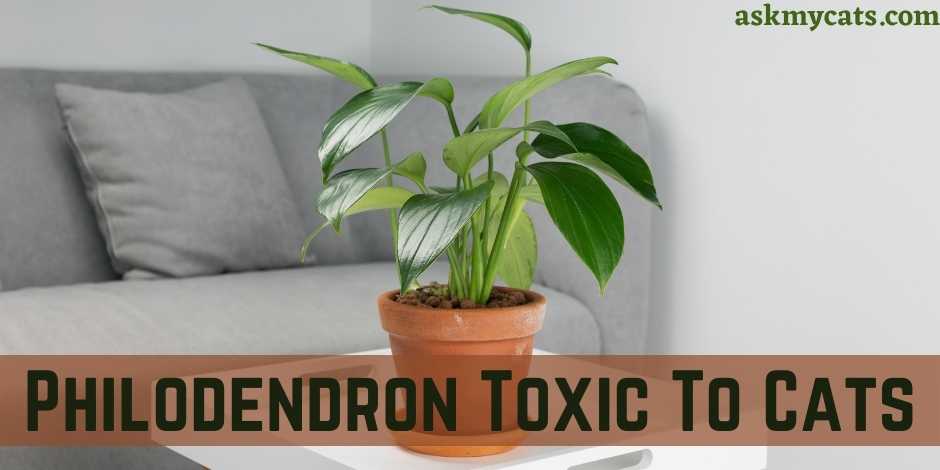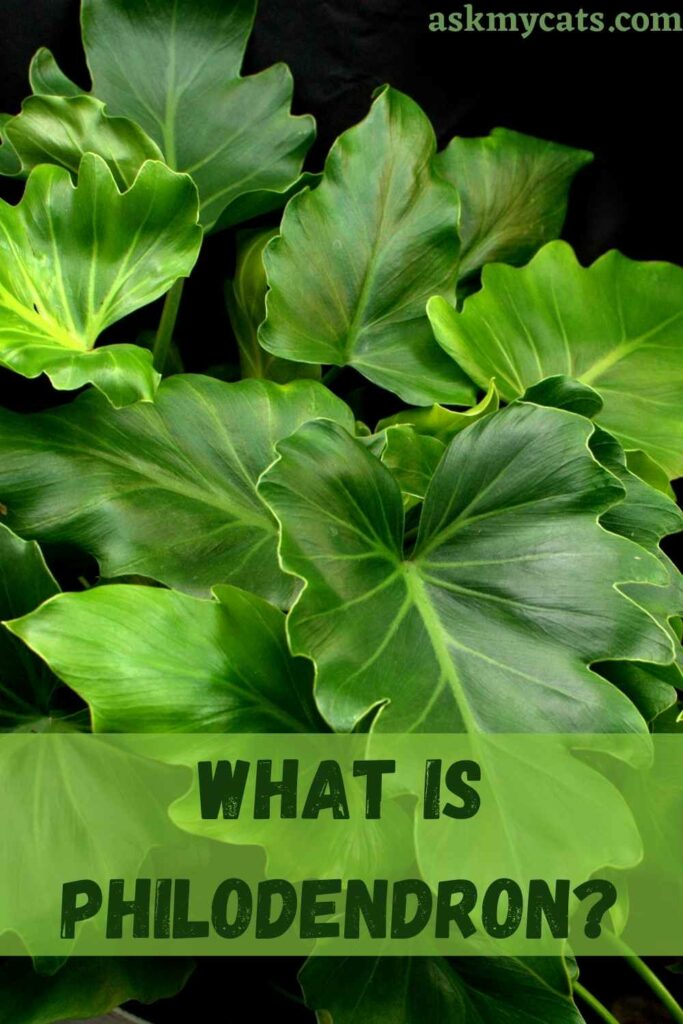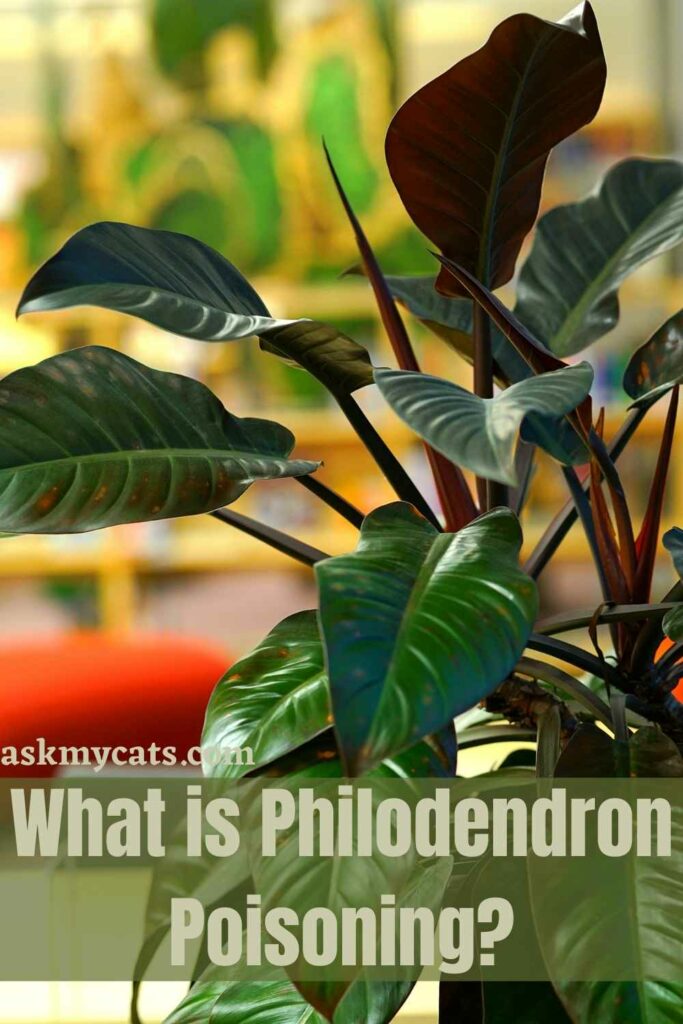Houseplants can be found in almost every home. They brighten your home, help to purify the air, and have been shown to help reduce anxiety and depression – not to mention that many people find caring for plants to be therapeutic.
Some cats are uninterested in plants and can be left alone in a room with toxic plants with no problems, but some furry felines enjoy nibbling on fresh plant leaves like philodendron.
However, is philodendron safe for cats?
No, philodendron is not safe for cats. For cats, the philodendron family, which includes Swiss cheese plant, heartleaf, and fiddle-leaf philodendron, has a mild to moderate toxicity level. Eating philodendron can cause oral irritation, pain and swelling of the mouth, tongue, and lips, excessive drooling, vomiting, and difficulty in swallowing in cats.
Read this article to know the relationship between cats and philodendrons.


Give Your Cat the Perfect Day
Get the Free Ebook!
What Is Philodendron?
Philodendron is a large genus of flowering plants in the family Araceae.

The World Checklist of Selected Plant Families accepted 489 species as of September 2015; other sources accept different numbers.
Regardless of species count, the genus is the second-largest in the Araceae family, after Anthurium.
The genus Philodendron is still poorly understood taxonomically, with many unnamed species.
Many are grown as indoor and ornamental plants. The name philodendron comes from the Greek words Philo-, which means “love, affection,” and dendron, which means “tree.”
Philodendron is the generic name, and “philodendron” is the English name.
As much as 0.7 percent of oxalates in the form of calcium oxalate crystals as raphides can be found in philodendrons.
If consumed by an average adult, the risk of death is extremely low, if at all possible, despite the fact that it is generally considered unhealthy.
Calcium oxalate crystals have a mild effect on humans in general, and large amounts must be consumed for symptoms to appear.
Increased salivation, a burning sensation in the mouth, swelling of the tongue, stomatitis, dysphagia, inability to speak, and edema are all possible symptoms. Mild dermatitis has also been reported as a result of contact with the leaves, with symptoms including vesiculation and erythema.
Is Philodendron Poisonous To Cats?
Yes, philodendron is poisonous to cats as per ASPCA.

Despite the fact that dogs and cats are primarily carnivores, they are also curious animals who occasionally nibble on plants.
You’ve probably noticed your cat grabbing a mouthful of grass in the backyard and occasionally tasting a weed.
There’s always the possibility that your pet will try out a house plant—or even eat it—which, in the case of Philodendron ingestion, could be fatal.
Philodendron is a popular indoor climbing plant with attractive, smooth, shiny leaves.
Some have broad, long, split leaves, while others have tear-dropped leaves.
These plants are frequently placed on coffee tables and shelves, where they gracefully spill out.
They thrive indoors and are hardy, which is one of the many reasons why homeowners bring them inside for decoration.
Horsehead Philodendron, Cordatum, Fiddle leaf, Panda plant, Split-leaf philodendron, Fruit salad plant, Red emerald, Red princess, and Saddle leaf are all common names for this plant.
Philodendron is poisonous to cats, and any ingestion should be reported to your veterinarian right away. If a cat consumes a large amount of philodendron, it may develop severe respiratory and digestive problems, which could be fatal.
A severe burning sensation is the first symptom that your cat may experience after eating philodendron. Agitation, pawing at the face and mouth, drooling, foaming, and coughing are all signs of this.
If your cat is having trouble swallowing, choking, or pawing at his or her mouth, it’s time to take him or her to the vet right away.
Philodendrons cause severe reactions in cats, and if a significant amount is consumed, the initial symptoms of difficulty swallowing and breathing will only worsen.
Convulsions, renal failure, and coma are all possible side effects of Philodendron poisoning. If you suspect your cat has eaten philodendron, don’t hesitate to contact your veterinarian.
How Poisonous Is Philodendron To Cats?
Philodendron is mildly poisonous to cats.
For your cats, the philodendron is mildly poisonous. Although it will not kill your cats, the effects will vary depending on how much of the plant is consumed.
Because the philodendron is poisonous to dogs and cats, we must make sure that your pets do not eat it. If you notice that your cat has nibbled on any part of the plant, you can estimate the amount by thoroughly inspecting the plant.
We will notice symptoms such as vomiting and swelling in your cat’s mouth or tongue. As soon as possible, contact your veterinarian or take your cat to the clinic. It’s best if you don’t try to cure your cat yourself, as this can make things worse.
Pets have no idea which plants or objects are harmful to them. They’re curious and innocent creatures who might nibble on your philodendron for no apparent reason.
We must make certain that our pets, such as cats and dogs, do not eat philodendrons. Almost all types of pets are poisoned by philodendrons. If your cat or dog nibbles on one or two leaves from the plant, it may not have much of an effect.
As a result, it’s best to relocate the plant so that neither your cat nor your children can access it. You can easily keep climbing philodendron in hanging pots if you have them. If the non-climbing ones are small, you can hang them. Otherwise, try to keep the plant out of reach of the animals.
What is Philodendron Poisoning?
Philodendron poisoning is when your cat shows symptoms like difficulty in swallowing, vomiting, and swelling in the mouth after eating philodendron.

Philodendrons are common houseplants with exotic leaves that are extremely popular among houseplant enthusiasts.
However, if you have cats or dogs in the house, you may be concerned about the philodendrons’ toxicity, as you don’t want to harm your plant or your pets.
Philodendrons are mildly toxic to cats and can cause them to be uncomfortable.
If your cat ingests any part of the philodendron, they will experience oral irritation, gastric issues, drooling, and swallowing difficulties.
If you notice any of these symptoms, take your cat to the veterinarian right away.
The poisonous substance calcium oxalate found in philodendron causes a lot of discomfort in your cat or dog.
You can keep your philodendron in the same house as your cat or dog, but the plant must be kept out of reach of your pets.
Philodendrons aren’t good for cats. Both cats and dogs are poisoned by the philodendron. If your cat eats any part of the philodendron, it will experience stomach irritation, vomiting, and difficulty swallowing.
To protect themselves from pests and bugs, philodendrons produce a toxin called calcium oxalate. Calcium oxalate is made up of sharp-edged crystal-like chemicals. As a result, even if the pet eats a single leaf, it will experience oral irritation and digestive problems. If this happens, you’ll notice a lot of drooling.
Calcium oxalate, a toxic crystal-like substance released by philodendrons, is harmful to your cat.
The toxin can irritate your pets’ mouths and cause their lips to swell. You’ll notice signs such as:
- Drooling
- Vomiting
- Pawing at the mouth
- Irritation to the mouth – lips, eyes, and tongue
- Foaming at the mouth
- Difficulty in swallowing
- Difficulty in breathing
These occur as a result of the toxin’s crystal form, which can cut the mouth and injure cats. Because this toxin is present in all parts of the plant, it can affect your cat if you eat any of them.
If you have a cat in the house, your philodendron must be kept away from it. You should also keep the plant out of your children’s reach. It’s natural for your cat to be interested in your houseplants, and unique foliage can pique their interest even more.
Philodendrons come in a variety of variegated species, which can pique your cats’ interests. It’s best if you can find a spot for the plant that is high enough to keep it away from your cats. To keep the philodendron at bay, use floating pots, hangers, or floating shelves.
Cats are more inquisitive than dogs. They have access to places that we do not. As a result, if you have cats in the house, you must exercise greater caution.
If you have a climbing philodendron, we can keep the plant in a floating pot and make sure the cat can reach the vine. Because cats dislike clusters, keep the plant in the bookshelf with other items like books to make it clustered.
You’ll be able to keep the philodendron away from your cat if you follow these guidelines. Keep your cat in a different room from the philodendron plant if you plan to leave the house for an extended period of time. This will keep the cat and the plant safe from each other.
Horsehead philodendron (also known as cordatum, fiddle-leaf, panda plant, split-leaf philodendron, fruit salad plant, red emerald, red princess, and saddle leaf) is a common, easy-to-grow houseplant that is toxic to dogs and cats.
This philodendron contains a chemical that can cause irritation in animals’ mouths, tongues, and lips. Increased salivation, vomiting, and difficulty swallowing may also occur in an affected pet.
Symptoms of Philodendron Poisoning in Cats
Symptoms of philodendron poisoning in cats include: –
- Respiratory issues
- Pawing at the mouth
- Vomiting
- Drooling
- Loss of appetite
- Difficulty in swallowing
Plants have the ability to bring a room to life. Plants are unlike other decorative focal points in that they are growing, ever-changing, living things that require your love and attention to thrive. They are rich in textures, colors, and shapes.
You should, however, avoid toxic plants that are harmful to cats as a pet parent. For example, philodendrons, one of the most popular houseplants of all time, contain insoluble calcium oxalates, a constituent found in a variety of other common indoor and outdoor plants, including many members of the Araceae family, including dieffenbachia, peace lily, Schefflera, and umbrella plant, among others. Unfortunately, this means philodendrons should not be kept near cats.
Human kidney stones are made up of insoluble calcium oxalates, which are also found in philodendrons. Its needle-like crystals can be found on plant leaves, stems, and other plant parts.
When the plant is chewed or bit by a dog or cat, the crystals embed themselves in the oral cavity, penetrating the tissue and causing pain and swelling of the mouth, tongue, and lips.
The gastrointestinal tract is also irritated, in addition to the mouth. According to the Pet Poison Helpline, swelling of the upper airway can make breathing difficult, but this is uncommon.
Cats with philodendron poisoning experience a severe burning sensation in their lips, tongue, and throat, which may cause them to paw at their faces.
Excessive drooling and foaming at the mouth are also signs of philodendron poisoning. Choking and throat swelling, as well as dysphagia, or the inability to swallow, are all possible poisoning symptoms.
These symptoms appear quickly but can last for up to two weeks after ingesting the substance.
If a cat eats too much philodendron, it can cause serious respiratory and digestive problems. Your cat’s breathing may be difficult, or he may breathe in rapid shallow gasps.
If he consumes a lot of philodendra, his symptoms will worsen, and he may experience convulsions, renal failure, and coma.
The cat will most likely die if not treated. Even if he recovers, severe calcium oxalate poisoning can permanently damage the liver and kidneys.
How To Treat Philodendron Poisoning In Cats?
To treat philodendron poisoning in cats rinse the mouth with milk or water.
Rinsing the mouth with milk or water is a veterinary treatment for insoluble calcium oxalate-containing plants like the philodendron.
DVM360, a professional resource for veterinarians, recommends giving calcium-containing products to reduce pain by causing soluble oxalates to precipitate in the oral cavity.
The prognosis is favorable, and the clinical signs usually fade away within 24 hours with no long-term consequences.
Many symptoms of contact with the calcium oxalate crystals from consuming philodendron plants are visible right away, which means that identifying the plant in combination with your canine’s symptoms is often enough to make an initial diagnosis.
Your veterinarian may recommend a visit to the office if your cat chooses to ingest large amounts of plant material or if you did not observe what your pet may have ingested.
You will be asked about any potential for inappropriate grazing, as well as any dietary supplements or medicinal prescriptions that your cat is currently taking.
When tests like a complete blood count, biochemistry profile, and urinalysis are run, they can reveal any coexisting diseases or disorders.
If your cat vomits after being exposed to plant material, the vomitus will be examined and tested for toxins. The presence of plant material in the vomitus will aid in the confirmation of the preliminary diagnosis.
Thorough flushing out of the mouth and other affected areas with fresh, cold water is usually the first step in immediate treatment.
This is done to get rid of as many annoying crystals as possible. Most cats will avoid consuming this plant due to its unpleasant taste and discomfort.
This means that rinsing the mouth area may be all that is required, though your cat may benefit from something cool to eat or drink, such as an ice cube or milk, to alleviate the oral discomfort until you can get more information from your veterinarian.
Depending on the circumstances, your cat may also be prescribed appropriate pain relievers or antihistamines.
A trip to the veterinarian’s office would almost certainly be recommended if large amounts of the plant material or sap were consumed.
To prevent dehydration, intravenous fluid treatment will be offered, and if an antihistamine has not been previously administered, it may be given as an intramuscular injection at this time.
Gastroprotective medications may be given to the patient in order to protect the stomach lining. If your cat’s airway has become significantly swollen, he or she should be kept in the veterinary office for observation until the swelling subsides.
Frequently Asked Questions
How do cats recover from philodendron poisoning?
Cats that ingest only small amounts of plants containing calcium oxalate crystals, such as the philodendron, usually have a good prognosis. The pain caused by the crystals in the mouth and gastrointestinal tract is frequently relieved within 12 to 24 hours of ingestion. A veterinarian should thoroughly evaluate and monitor any swelling in the airway. Due to the initial pain and discomfort in the mouth, large doses of plants containing calcium oxalate crystals are uncommon. Pets who consume large amounts of these plants risk liver and kidney damage, so close monitoring of these organs is necessary if large amounts of sap are consumed.
What are the causes of philodendron poisoning in cats?
The calcium oxalate crystals found in all parts of the philodendron can be harmful to your cat. Calcium oxalate is an oxalic acid-based calcium salt that causes irritation and numbness in the tissues it comes into contact with. Chewing any part of the plant causes immediate swelling and stinging pain in your cat’s mouth and throat as the tiny crystals embed themselves deep into the soft tissues nearby. If you swallow any of the sap or plant material, the inflammation will usually spread down your throat and into your gastrointestinal tract. Your cat may experience distress as well as severe internal pain as a result of this. If the airway becomes blocked, swelling of the tongue and throat has been known to cause breathing problems.
What should I do if my cat ate philodendron?
If you need to give your cat first aid for mild oral reactions, rinse her mouth with water and give her yogurt, milk, cheese, or any other calcium-rich food. This will help to neutralize the calcium oxalate. Antihistamines like diphenhydramine (Benadryl) can help to reduce swelling and open airways. Some antacids may also help her stomach, but she may be dehydrated if she continues to vomit or develops diarrhea. Always seek the advice of a veterinarian before administering any medications.
Final Words
Philodendrons are poisonous to cats, so keep them away from the plant. Once you understand how to keep cats away from the philodendron or find an ideal spot for the philodendron, you can easily keep it in the house with your cats.
If you have any questions, ask us in the comments section.
